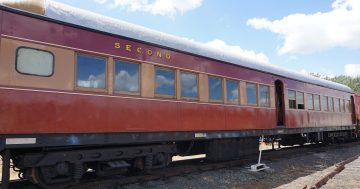 The ACT’s heritage trains may be running again by the end of the year after a better than expected result from the August auction of carriages and other assets after the Canberra Rail Museum was forced into liquidation owing $700,000.
The ACT’s heritage trains may be running again by the end of the year after a better than expected result from the August auction of carriages and other assets after the Canberra Rail Museum was forced into liquidation owing $700,000.
The liquidator, Deloites’ Eddie Senatore, said he was moving towards the tail end of the business and hoped to have his report to creditors completed by the end of the month.
“I think we have enough to get creditors a lot more than originally anticipated,” he said.
He did not see any need for further sell-offs, meaning significant assets such as the prized Beyer-Garratt 6029 locomotive, were safe and would remain part of the heritage rail fleet.
Although the financial situation was complex, Mr Senatore was hopeful he could move on in November to establishing a new management structure for the remaining rail assets.
“We’re going to try to reconstitute an organisation to manage the assets and hold them is some sort of structure where they’re protected, and then allow members to set up a new corporation basically to continue to operate them,” he said.
The key would be keeping any trust and new corporation separate so there was no confusion or conflicts of interest.
“That way the risks associated with the business activity sit with those people who are running those activities and the trust is simply there to manage and preserve and protect the asset,” Mr Senatore said.
“In the past there was a co-mingling of that activity. The trust was using and charging and there was an intermingling of bank accounts and it was difficult to separate some of the transactions.”
The new corporation would hire or lease carriages or machines from the trust for a fee, with the trust charging rates sufficient to cover repairs and maintenance of those trains. The new business would then charge enough to cover that fee, together with the cost of running the train including staffing, water and coal.
“By having those arms essentially separated there’ll be more robust discussion around what the fees will be. It’s what they ought to have been doing in the past,” Mr Senatore said.
Mr Senatore believed that while the management and mechanics of the business would be different, those working on and running the trains – the volunteers and members of the Australian Railway Historical Society ACT – would be the same.
“The members will be given that opportunity. In the end there are trains there, there are activities to be undertaken, and volunteers will always be needed,” he said.
Mr Senatore had not been talking to the ACT Government, which has previously rejected calls for outright financial support, but said there would be an opportunity for the new corporation to engage with the Government in the future about its activities, such as carriage restoration.
He also believed there were opportunities for private injections. “There is plenty of interest out there. There is a bit of dialogue happening in the marketplace,” he said.





















